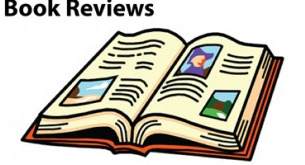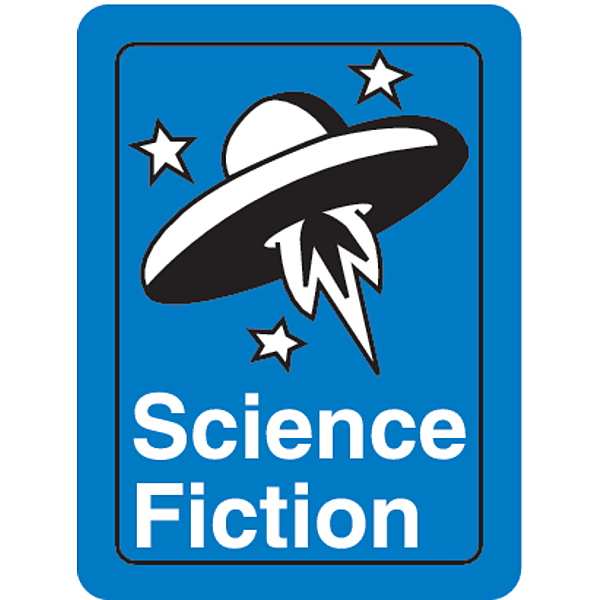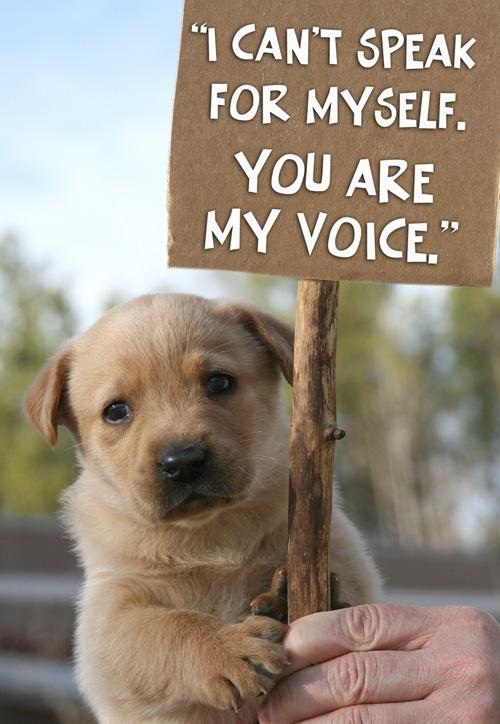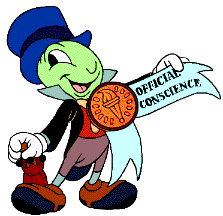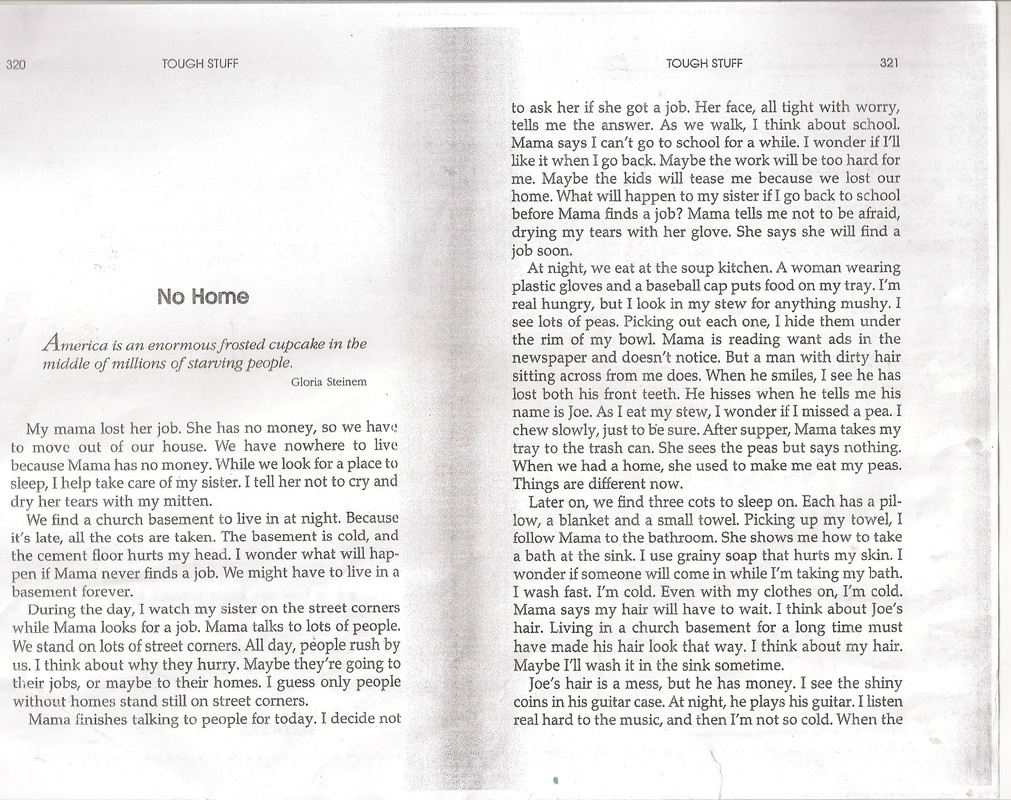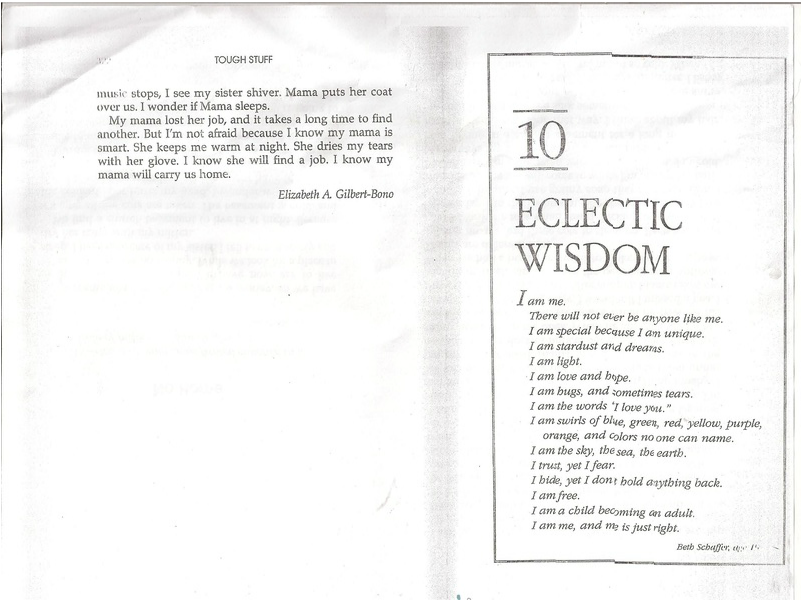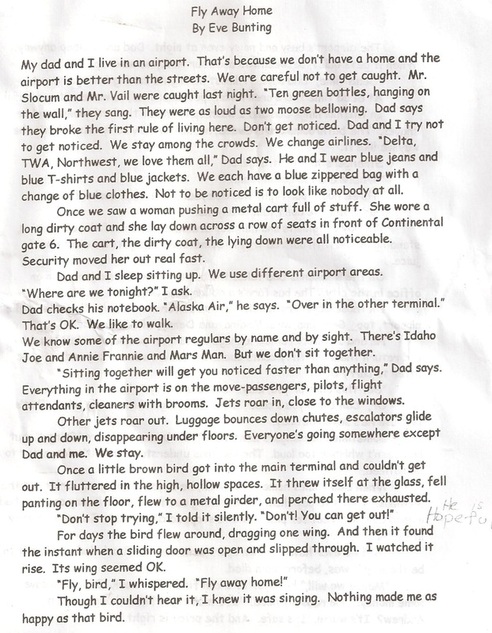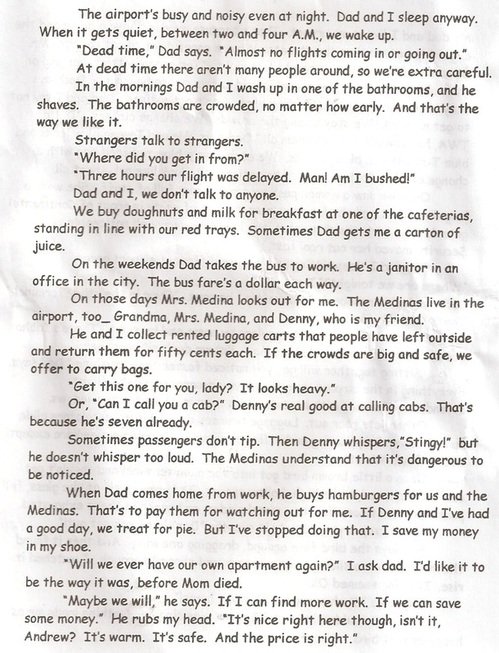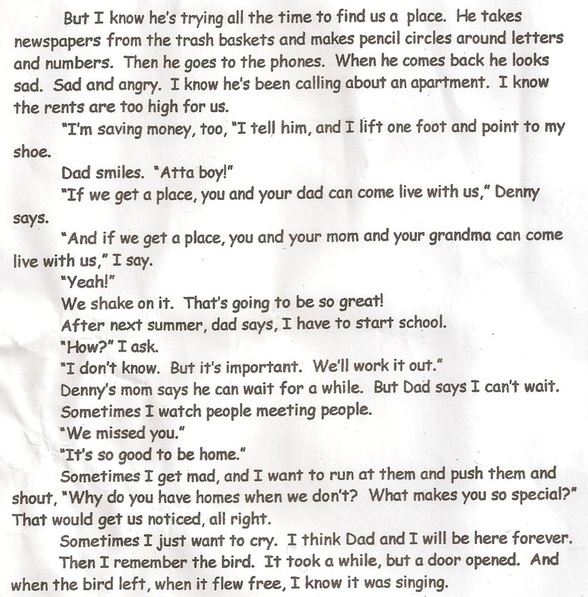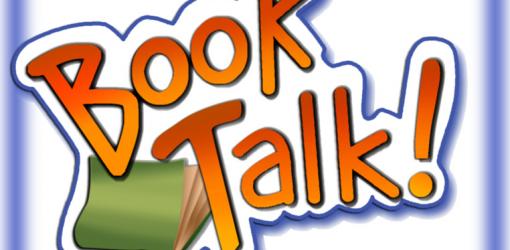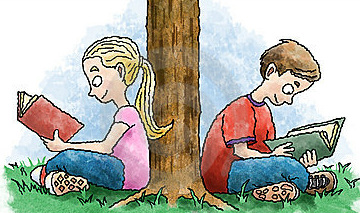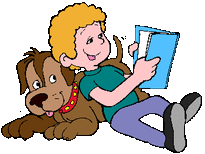Throughout the school year, students will be reading various genres within their level. We will utilize the "Ready Gen" reading series and students will also will be engaged in book clubs, partnerships, Author Studies, and much, much more. They will be studying various themes and topics and will be looking at them through many different books and perspectives. They will learn to critically analyze texts in order to form theories and opinions about the issues and concepts in the world around them. It is through reading that we will explore the concept of "learning how to live" and apply those lessons taught to the situations that surround our lives each day. Most importantly, students will learn strategies for finding evidence across many different levels and texts in order to formulate strong arguments for their opinions.
FINAL HOLOCAUST BOOK CLUB PACKETS:
| holocaust_book_clubsfinalpacket.doc | |
| File Size: | 28 kb |
| File Type: | doc |
Your browser does not support viewing this document. Click here to download the document.
What is an allegory? Why do you think this story is an allegory? What do the animals stand for? Why don’t the animals in the story help one another?
Select an animal mentioned in the story. Could that animal have done anything to stop the “terrible things” from happening? What are some possible things that the animal could have done to help the others who were being taken away?
Why do people sometimes hurt each other? How do they justify doing so?
How can you connect the animals in the story to real life?
How may this connect to the Holocaust?
Come up with your own high order thinking question based on the text.
Select an animal mentioned in the story. Could that animal have done anything to stop the “terrible things” from happening? What are some possible things that the animal could have done to help the others who were being taken away?
Why do people sometimes hurt each other? How do they justify doing so?
How can you connect the animals in the story to real life?
How may this connect to the Holocaust?
Come up with your own high order thinking question based on the text.
TERRIBLE THINGS TEXT:
Your browser does not support viewing this document. Click here to download the document.
HOLOCAUST BUTTERFLY GROUP ACTIVITY-PLEASE COMPLETE WITH YOUR GROUP: http://www.hilliardschools.org/sec/webquest/subpages/butterfly/ButtterflyJournal.pdf
PLEASE USE RESOURCES HERE TO GUIDE YOUR BUTTERFLY PACKET: http://www.hilliardschools.org/sec/webquest/subpages/butterfly/Butterflywebquest2.htm
HOLOCAUST RESOURCES:
HOLOCAUST NUMBR 4: DU THURSDAY, JUNE 11
|
HOLOCAUST BOOK CLUBS REVISED DUE WEDNESDAY: | ||||||
HOLOCAUST DUE WEDNESDAY, JUNE 3 (REVISED):
HOLOCAUST BOOK CLUBS #3:
DUE Friday, June 5
ALL: PREPARE FOR POST IT CHATS AND WRITE TWO HIGH ORDER THINKING QUESTIONS
DANIEL’S STORY—READ through chapter 12
THE DEVIL’S ARITHMETIC
READ CHAPTERS through 13
THE UPSTAIRS ROOM—read through chapter 9
HOLOCAUST BOOK CLUBS #3:
DUE Friday, June 5
ALL: PREPARE FOR POST IT CHATS AND WRITE TWO HIGH ORDER THINKING QUESTIONS
DANIEL’S STORY—READ through chapter 12
- What role did music play in Erika’s and Daniel’s lives?
- Why was the resistance movement so important to Daniel and the other young people?
- Why did Daniel begin to scavenge?
- How did good news about the war become bad news for Daniel?
- Do you think Daniel was justified in scavenging wooden objects from the apartment of the dead man? Explain.
- Is there anything that is as important to you as Erika’s music was to her? Explain. How would you feel if it were taken away from you? Explain.
- Do you think Daniel’s father made the right decision in accompanying his wife and daughter? Explain.
- Why do you think some individuals survived Nazi persecution while others did not?
- Were character traits or chance more significant and important in survival? Explain.
- When and where did the D Day invasion occur? What was the plan? Which Allied forces were involved? How successful were the Allies?
THE DEVIL’S ARITHMETIC
READ CHAPTERS through 13
- What do you think the badchan meant when he uttered each of the following proverbs:
- The snake smiles but shows no teeth?
- Better the fox to guard the hens and the wolves to guard the sheep?
- Do you think the Jews really believed they were being resettled? Explain. Why do you think they continued to believe they had a future despite what was happening to them?
- What promise did Gitl have Hannah make? Why do you think she asked her to make that promise?
- After Hannah’s hair was shorn, the author writes, “Everything felt strange, alien as if she were on another planet, as if she were on the moon.” Why is this comparison being made? Explain.
- Why do you think Hannah felt that thinking ws dangerous in this place?
- Why was Hannah revolted by the clothes in the pile for Jewish inmates? What did this suggest about the origin of the clothing (where it came from)?
- Why do you think the Nazi soldiers shaved the heads of all the prisoners and tattooed numbers on their arms?
- Contrast the ways in which Gitl and Fayge adapted to life in the concentration camp.
- Which of the two would be more likely to survive? Why?
- How were Hannah’s feelings about her home and Seder beginning to change? Explain.
THE UPSTAIRS ROOM—read through chapter 9
- Why do you think it is harder for Sini than for Anne to endure the time in hiding?
- How can you tell that the Oostervelds thought of the girls as part of their family?
- How do you think Anne’s attitude and behavior will change now that she appreciates the danger facing her, Sini and the Oostervelds?
- What was Sini’s main concern as she considered the passage of time?
- Do you think Sini’s worries about her appearance were realistic? What did the suggest about her character?
- Why do you think Annie behaved in an uncharacteristically rude manner during Miss Kleinhoote’s visit?
- What wish do you think each of the girls and each member of the Oosterveldt family made for the new year of 1944?
- Why do you think Rachel was so critical of Anne during her short visit?
- Do some research and find out when and where the Allied invasion of Normandy took place and the effect it had upon the war ending in Europe. How might the invasion of Normandy in France have affected the lives of Annie and Sini in Holland?
- Why did the girls start laughing uncontrollably? Explain a time that may have happened to you.
- Imagine you are Rachel. Describe how she may have felt after visiting her sisters and tell why you feel this way.
HOLOCAUST #2-DUE WEDNESDAY, JUNE 3
DEVIL’S ARITHMETIC
READ THROUGH CHAPTER 8
Vocabulary:
Illusion, hypnotic, conspiracy, lucid, dour, dominant, timid.
Reflect and respond:
- What did Hanah find the strangest of all in her “dream?”
- What did Yitzchak bring as a wedding gift for Shmuel and Fayge? What did this reveal about the people in the shtetl?
- Discuss Gitl’s attitude towards life in Lubiln. How did she feel about “country” life as contrasted to “city” life? Do you think rural people tend to be distrustful of city life and vice versa? Explain.
- What kinds of stories did Hannah tell the girls? How did they respond to her? What does this reveal about the girls?
- What was the role of the shadchan in the village? What role did the badchan play at the wedding?
- Why do you think Hannah gave an involuntary shudder when she saw the army trucks and old fashioned cars in Viosk?
- When the badchan saw the Nazi soldiers, he said, “I see the malach ha mauvis. I see the angel of death.” What do you think he mant by this? How do you think his comments might foreshadow events to come later in the book?
- Hannah finds she is no longer Hannah but Chaya which means “life” in Hebrew. What significance do you think this name might have, given the setting of this book?
DANIEL’S STORY
READ THROUGH CHAPTER 6
Vocabulary:
Decreet, looting, deport, evacuate, exempt, squalor, habitual.
- How was Daniel’s family affected by kristallnacht, November 10, 1938?
- Why were many adults suspicious of Daniel when he tried to take their picture?
- Why do you think many countries would not accept Jews who were trying to escape Nazi persecution? Do you think the same thing would happen today? Explain.
- Do you think Oma Miriam should have given Daniel the uniform? Explain.
- Do you think the remaining Jewish population in Frankfurt should have challenged their deportation? Explain.
- Do you think Aunt Leah and Daniel’s family made the right decision about Leah’s children? Explain. Did they have any other options?
- What do you think Rosa meant when she said, “Hope is our enemy? Do you agree with her or with Erika who felt that hope sustained life? Explain.
- What did the radio symbolize to Daniel and the others? Why was it so important to them?
THE UPSTAIRS ROOM
READ CHAPTERS THROUGH CHAPTER 5
Vocabulary:
Frail, abruptly, labor, glum, deftly, gingerly, clench, elevated
- Do you think Mr. de Leeuw should have agreed to leave Winterswijk while his wife was in the hospital? Explain.
- Why do you think some Dutch families were willing to risk hiding Jews?
- How do you think Annie felt as she left Winterswijk by bus? How do you think her life will change while she is in hiding?
- How did Annie show resourcefulness and bravery as she began her bus trip? How would you have reacted under similar circumstances?
- Why do you think Annie and Sini were irritated with one another during their first days at the Hanniks’ farm?
- If you were Annie or Sini, would you rather stay with the Hanniks or the Oostervelds? Why?
- How do you learn that the Oostervelds are simply country people, perhaps with less education and culture than anyone Annie knew?
- Why do you think Annie and Sini preferred living with the Oostervelds over living with the Hanniks?
Your browser does not support viewing this document. Click here to download the document.
- Preview the book by reading the title, blurb and cover. Predict what the story may be about? Does the title provide any insight into what the story may be about?
- Discuss what you already know about this era. Have you read any other books about this era? Discuss.
- Many of the families in these stories leave most of their belongings behind when they flee their native country or go into hiding. If you could only take a few of your most prized possessions, which would you choose and why?
- What effect do you think it would have on the children from being separated from their parents and other family members? (Besides the obvious of being scared).
- What role do religious holidays play in helping people remember their past? Why are they important?
- When the Nazis took over Holland some Gentiles (non Jews) hid Jewish friends or neighbors in their homes so the Nazis would not take them away to concentration camps. If you had to devise a plan to hid a friend from cruel officials of an unjust government—discuss:
- Where could your friend stay so their whereabouts would be secret?
- How could you get food to your friend?
- What quiet activities could they do to pass time while in hiding?
- If officials searched in or near the hiding place, what could you do to make sure they could not find your friend?
HOLOCAUST #2 DUE WEDNESDAY, JUNE 3:
| holocaust_book_clubs2_(1).doc | |
| File Size: | 29 kb |
| File Type: | doc |
HOLOCAUST PREVIEWING AND PACKET NUMBER ONE:
Your browser does not support viewing this document. Click here to download the document.
FINAL SCI FI TASK PERFORMANCE: DUE WEDNESDAY, MAY 27
| scifitaska_tour_through_space.docx | |
| File Size: | 116 kb |
| File Type: | docx |
Your browser does not support viewing this document. Click here to download the document.
WRITING BOOK REVIEWS:
|
PLEASE MAKE SURE YOU INCLUDE INFO REGARDING THE AUTHOR AND WHY HE OR SHE WROTE THE BOOK.
|
| ||||||
| writing_strategies_for_persuasive_reviews.docx | |
| File Size: | 131 kb |
| File Type: | docx |
|
PLEASE USE CRITERIA FROM ABOVE AND AUTHOR RODMAN PHILBRICK'S TUTORIAL TO ASSIST YOU. TRY TO TALK TO YOUR READER AND DO SOME INVESTIGATION ABOUT THE AUHTOR. FIND OUT WHY HE OR SHE WROTE THE BOOK AND CONSIDER HOW IT IS SIMILAR-DIFFERENT TO OTHER BOOKS HE OR SHE WROTE OR SIMILAR TO BOOKS TO OTHER AUTHORS.
|
BOOK REVIEWS FOR ANIMAL ISSUES BOOK CLUBS: DUE WEDNESDAY, MAY 20 |
EMPATHY POWERPOINT:
Your browser does not support viewing this document. Click here to download the document.
BOOK CLUB RUBRIC:
| doc+-+mar+24,+2015,+3-15+pm.pdf | |
| File Size: | 547 kb |
| File Type: | |
LITERARY TERMS REVIEW POWERPOINT:
Your browser does not support viewing this document. Click here to download the document.
SCI FI POWERPOINT:
| sci-fi-ppt1.ppt | |
| File Size: | 648 kb |
| File Type: | ppt |
WRINKLE IN TIME CHAPTER 12 QUESTIONS: DUE MONDAY, JUNE 8 ESSAY: WEDNESDAY, JUNE 10
Your browser does not support viewing this document. Click here to download the document.
| wrinkle_in_time_chapter_12.docx | |
| File Size: | 12 kb |
| File Type: | docx |
WRINKLE IN TIME-CHAPTER 11: DUE FRIDAY, MAY 29
. Focus on how love and kindness begins to change Meg.
1. Consider Meg’s unreasonable expectations of her father. What would have happened if they stayed and tried to get Charles away from IT? How unreasonable is it for Meg to blame her father for not protecting her tessering through the black Thing? Explain.
2. Discuss the irony of Meg’s childish behavior toward Mr. Murry and the beast treating her like a baby. What is the behavior of the beast that Meg needs to learn? How does Meg react to the attention of the beast?
3. Think about the human characteristic-tendency that causes people to need to give a name to everything. Why does Meg want to give a name to the beast? What is the implication-consequence of calling the beast Aunt Beast?
4. Why is Aunt Beast confused by Meg’s insistence on seeing and light?
5. How do other senses increase in the absence of sight?
6. What are some things that make up for the beast’s lack of vision? How does the beast communicate with other creatures and planets?
7. A theme of music happens on this planet. Where was it important before?
8. How does anger cause people to behave in ways they ordinarily would not?
9. What is the irony of Meg wanting so much to rescue her father and then turning on him over things he could not control? Is Meg not giving him credit for holding out against IT as long as he did? Explain.
1. Consider Meg’s unreasonable expectations of her father. What would have happened if they stayed and tried to get Charles away from IT? How unreasonable is it for Meg to blame her father for not protecting her tessering through the black Thing? Explain.
2. Discuss the irony of Meg’s childish behavior toward Mr. Murry and the beast treating her like a baby. What is the behavior of the beast that Meg needs to learn? How does Meg react to the attention of the beast?
3. Think about the human characteristic-tendency that causes people to need to give a name to everything. Why does Meg want to give a name to the beast? What is the implication-consequence of calling the beast Aunt Beast?
4. Why is Aunt Beast confused by Meg’s insistence on seeing and light?
5. How do other senses increase in the absence of sight?
6. What are some things that make up for the beast’s lack of vision? How does the beast communicate with other creatures and planets?
7. A theme of music happens on this planet. Where was it important before?
8. How does anger cause people to behave in ways they ordinarily would not?
9. What is the irony of Meg wanting so much to rescue her father and then turning on him over things he could not control? Is Meg not giving him credit for holding out against IT as long as he did? Explain.
WRINKLE IN TIME-CHAPTER 10: DUE MONDAY, MAY 18:
| wrinkle_in_time_chapter_ten.docx | |
| File Size: | 105 kb |
| File Type: | docx |
WRINKLE IN TIME CHAPTER 9 DUE TUESDAY, MAY 5:
ESSENTIAL QUESTION: Who/what is IT, and how does IT control others? How is Meg’s character developing? What is the difference between knowledge and wisdom? Begin reading chapter 9. New packet is due on Tuesday, May 5th.
Part One: Select your own hot question and add your smart thinking.
Part two: Choose two new vocabulary words with their definitions and parts of speech.
Part Three: Reflect and respond:
1. What is IT? What does IT do?
2. Theme Discussion: Knowledge vs. Wisdom
Why do you think L’Engle chose to make IT a “disembodied brain”? How does It control others?
What does Meg have that IT does not?
3. What stops Meg from killing the brain? In other words, what may die along with the brain?
4. Why is Meg the one most affected in the tesseract?
5. How is the theme – knowledge vs. wisdom – developed in Chapter 9?
Discuss: How is Meg’s character developing? (How did Meg’s faults help her?
6. Compare and contrast Meg in Chapter 1 with Meg in Chapter 9
How did she feel at the beginning of the chapter? How did this feeling change as the chapter progressed?
7. What is Calvin’s gift? Why does his talking to Charles Wallace eventually fail? What does that say about the strength of the evil? Why is Calvin exhausted after talking to Charles Wallace?
8. What do you think the significance of Mrs. Who’s glasses are? Any symbolism? If the strange women represent pure good, how does that explain Mr. Murry’s being able to see with Mrs. Who’s glasses?
9. What else have you learned in this chapter in the concept of knowledge vs. wisdom?
Part One: Select your own hot question and add your smart thinking.
Part two: Choose two new vocabulary words with their definitions and parts of speech.
Part Three: Reflect and respond:
1. What is IT? What does IT do?
2. Theme Discussion: Knowledge vs. Wisdom
Why do you think L’Engle chose to make IT a “disembodied brain”? How does It control others?
What does Meg have that IT does not?
3. What stops Meg from killing the brain? In other words, what may die along with the brain?
4. Why is Meg the one most affected in the tesseract?
5. How is the theme – knowledge vs. wisdom – developed in Chapter 9?
Discuss: How is Meg’s character developing? (How did Meg’s faults help her?
6. Compare and contrast Meg in Chapter 1 with Meg in Chapter 9
How did she feel at the beginning of the chapter? How did this feeling change as the chapter progressed?
7. What is Calvin’s gift? Why does his talking to Charles Wallace eventually fail? What does that say about the strength of the evil? Why is Calvin exhausted after talking to Charles Wallace?
8. What do you think the significance of Mrs. Who’s glasses are? Any symbolism? If the strange women represent pure good, how does that explain Mr. Murry’s being able to see with Mrs. Who’s glasses?
9. What else have you learned in this chapter in the concept of knowledge vs. wisdom?
WRINKLE IN TIME CHAPTER 8: DUE THURSDAY, APRIL 30
| wrinkle_in_time_chapter_8.docx | |
| File Size: | 12 kb |
| File Type: | docx |
WRINKLE IN TIME CHAPTER 7-DUE FRIDAY, APRIL 24:
| wrinkle_in_timechapter7.docx | |
| File Size: | 13 kb |
| File Type: | docx |
Your browser does not support viewing this document. Click here to download the document.
WRINKLE IN TIME CHAPTER SIX: DUE FRIDAY, APRIL 17:
| wrinkleintimechapter6.docx | |
| File Size: | 77 kb |
| File Type: | docx |
Your browser does not support viewing this document. Click here to download the document.
WRINKLE IN TIME CHAPTERS FOUR AND FIVE: DUE WEDNESDAY, APRIL 1ST (NO JOKE--EVEN THOUGH IT'S APRIL'S FOOLS DAY)
Your browser does not support viewing this document. Click here to download the document.
WRINKLE IN TIME-CHAPTER 3-DUE FRIDAY, MARCH 27: PLEASE COMPLETE BOTH SECTIONS BY FRIDAY
~a conflict that takes place within the mind of a character~
1. In your own words, describe Meg’s internal conflict.
2. “I hate being an oddball,” Meg said. “It’s hard on Sandy and Dennys, too. I don’t know if they’re really like everybody else, or if they’re just able to pretend they are. I try to pretend, but it isn’t any help.”
A Wrinkle in Time-What is Meg’s struggle in this passage? Why does she try to pretend?
3. PREDICT HOW THIS FITS INTO THE STORY’S MAIN IDEA-THEME.
4. “Do you think things always have an explanation?” “Yes. I believe that they do. But I think that with our human limitations we’re not always able to understand the explanations. But you see Meg, just because we don’t understand doesn’t mean that the explanation doesn’t exist.”
A Wrinkle in Time, Ch. 3 Do you agree or disagree with this statement? Why?
5. What have we learned so far about the tesseract? Analyze Mrs. Murry’s reaction when Mrs. Whatsit mentions it. What is the feeling the author creates with this strange sounding word?
6. The tesseract is something difficult to understand by most people. Explain why people have the need to explain anything they do not otherwise understand.
1. In your own words, describe Meg’s internal conflict.
2. “I hate being an oddball,” Meg said. “It’s hard on Sandy and Dennys, too. I don’t know if they’re really like everybody else, or if they’re just able to pretend they are. I try to pretend, but it isn’t any help.”
A Wrinkle in Time-What is Meg’s struggle in this passage? Why does she try to pretend?
3. PREDICT HOW THIS FITS INTO THE STORY’S MAIN IDEA-THEME.
4. “Do you think things always have an explanation?” “Yes. I believe that they do. But I think that with our human limitations we’re not always able to understand the explanations. But you see Meg, just because we don’t understand doesn’t mean that the explanation doesn’t exist.”
A Wrinkle in Time, Ch. 3 Do you agree or disagree with this statement? Why?
5. What have we learned so far about the tesseract? Analyze Mrs. Murry’s reaction when Mrs. Whatsit mentions it. What is the feeling the author creates with this strange sounding word?
6. The tesseract is something difficult to understand by most people. Explain why people have the need to explain anything they do not otherwise understand.
Your browser does not support viewing this document. Click here to download the document.
WRINKLE IN TIME PART TWO: TUESDAY, MARCH 24:
Your browser does not support viewing this document. Click here to download the document.
Your browser does not support viewing this document. Click here to download the document.
WRINKLE IN TIME: PART ONE-DUE
THURSDAY, MARCH 19
Your browser does not support viewing this document. Click here to download the document.
Your browser does not support viewing this document. Click here to download the document.
ANIMAL ISSUES BOOK CLUBS:
ANIMAL ISSUES PART FIVE: DUE THURSDAY, APRIL 2:
| animal_issues_book_clubs_packet5.docx | |
| File Size: | 14 kb |
| File Type: | docx |
ANIMAL ISSUES PART 4: DUE MONDAY, MARCH 23:
| animal_issues4.docx | |
| File Size: | 14 kb |
| File Type: | docx |
ANIMAL ISSUES PART THREE: DUE TUESDAY, MARCH 17:
| animalissues3.docx | |
| File Size: | 19 kb |
| File Type: | docx |
ANIMAL ISSUES PART TWO-DUE THURSDAY, MARCH 12TH:
| animalissuesbookclubsparttwo.docx | |
| File Size: | 16 kb |
| File Type: | docx |
| animalissuespreviewpartone.docx | |
| File Size: | 19 kb |
| File Type: | docx |
CIVIL RIGHTS LITERARY ESSAYS-DUE WEDNESDAY, FEBRUARY 25:
| civil_rights_book_clubsliteraryessay.doc | |
| File Size: | 39 kb |
| File Type: | doc |
MAKING ETHICAL DECISIONS:
| making_ethical_decisions.pptx | |
| File Size: | 1740 kb |
| File Type: | pptx |
MAKING ETHICAL DECISIONS-BOOK CLUB GROUP RESPONSE:
MAKING ETHICAL DECISION RESPONSE TO LITERATURE-DUE MONDAY, FEBRUARY 9:
| making_ethical_decisions.doc | |
| File Size: | 45 kb |
| File Type: | doc |
COMPARATIVE ESSAY FOR ESCAPE TO FREEDOM AND ANGEL ISLAND:
| comparative_essay_rubric.doc | |
| File Size: | 27 kb |
| File Type: | doc |
| comparativeessaystructure.jpg | |
| File Size: | 306 kb |
| File Type: | jpg |
| compessayescapetofreedomangelisland.docx | |
| File Size: | 17 kb |
| File Type: | docx |
TWO YOUNG WOMEN POEM:
Your browser does not support viewing this document. Click here to download the document.
1. What is the poet is trying to say? What is the poet's message or point?
2. Which countries do you think these two young women are from? Why? Do you think that life for young women in these countries is getting better or worse? Why?
3. Which of these women's lives is more similar to yours? How is it the same? How is it different?
4. What else can you imagine about the lives of these two women?
5. The last line of the poem ends with “I can get out.” What does this young women want to get out of? Is she more or less trapped than the other young woman? Why?
6. Stop and jot any other ideas-questions-wonderings.
2. Which countries do you think these two young women are from? Why? Do you think that life for young women in these countries is getting better or worse? Why?
3. Which of these women's lives is more similar to yours? How is it the same? How is it different?
4. What else can you imagine about the lives of these two women?
5. The last line of the poem ends with “I can get out.” What does this young women want to get out of? Is she more or less trapped than the other young woman? Why?
6. Stop and jot any other ideas-questions-wonderings.
CIVIL RIGHTS #3: DUE WEDNESDAY, JANUARY 21:
| civil_rights_book_clubs3_1.doc | |
| File Size: | 33 kb |
| File Type: | doc |
CIVIL RIGHTS BOOK CLUBS PREVIEW & PACKET #1 &2:
| civilrightspreview1.docx | |
| File Size: | 13 kb |
| File Type: | docx |
| civilrightspacket_number_one.docx | |
| File Size: | 16 kb |
| File Type: | docx |
| civilrights2_1.doc | |
| File Size: | 30 kb |
| File Type: | doc |
GET THE WORD OUT TASK AND RUBRIC:
|
| ||||||||||||
"THINGS TO CONSIDER" WHEN PUTTING YOUR ESSAY-TASK TOGETHER:
*** DON'T FORGET O CITE YOUR RESOURCES (NAME OF BOOK-ARTICLE AND AUTHOR OR REFER TO WEBSITE ARTICLE--INCLUDE IN YOUR ESSAY AND AT THE END UNDER "WORKS CITED:" USE MLA STYLE. http://www.citationmachine.net/
BE SURE TO INCLUDE A CATCHY TITLE, ENGAGING LEAD-INTRO AND BIG BANG ENDING (SEE WRITING SECTION FOR ASSISTANCE). BOLD-FACE POWER WORDS-DOMAIN SPECIFIC VOCABULARY WORDS. INCLUDE PHOTOS THAT RELATE TO THE MAIN IDEA AND HAVE A CAPTION UNDERNEATH (SMALLER FONT) THAT SUMMARIZES WHAT THE PHOTO IS ABOUT.
Plan an Informative Essay. Use adjectives correctly. An informative essay gives information in words and often includes visuals. It should present info in a way that catches the reader’s interest. To plan an informative essay The writer chooses a topic for a specific purpose and audience and organizes the key details in an easy to read format.
Analyze the Model: Discuss purpose and audience. Consider how the writer uses a section heading to introduce the topic and includes key terms and details to develop it.
• What is the purpose?
• Who is the audience?
• What is the topic?
• What key details and vocabulary support the topic?
THE AMAZON RAIN FOREST
THE AMAZON RIVER BASIN IS HOME TO THE LARGEST RAIN FOREST IN THE WORLD. IT STRETCHES FROM PERU TO EASTERN BRAZIL. THE AREA CONTAINS ALMOST HALF OF THE TROPICAL RAIN FOREST HABITAT LEFT IN THE WORLD. (Introduces the topic with a heading and supports the topic with key terms and details.
Adjectives tell what kind and how many. Poison dart frogs have unique defenses. Many endangered species have lost their habitat. Use page 68 in journals to practice using adjectives.
Now start to prepare to write your informative article: about an ecosystem in jeopardy. The audience is people interested in traveling for the purpose of learning about the environment, wildlife and natural habitats (eco tourism). The subject: Ecosystem becomes the title of the outline. Three or more Roman numerals show topics for the section headings in their brochures. Students develop:
• Section headings related to their chosen ecosystem.
• Key details and terms to include in each section.
• Consider possible section headings, key details and terms to include. Keep in mind purpose and audience. Include ideas for visuals.
• Conventions: s verb tense consistent throughout?
• • Are adjectives and adverbs used correctly?
• • Are quotations capitalized and punctuated correctly?
• • Are all words spelled correctly?
•
Students will write a clear and logical informative essay that
describes how the rain forest environment is changing.
Students will
a. introduce the topic using an observation that leads to the
larger topic.
b. explain how the plants and animals are being affected and how
that affects people.
c. use graphs, charts, definitions, and quotations to help support
their work.
d. use precise, scientific, domain-specific language and
vocabulary to inform the reader.
e. provide a conclusion that summarizes their information.
Does each sentence contain a noun and a verb and express a
complete thought?
• Do subjects and verbs agree in number?
• Are verb forms and tenses correct and consistent?
• Does each sentence end with the correct punctuation mark?
• Are quotations properly capitalized and punctuated?
• Are the first word in each sentence and each proper noun capitalized?
• Are the first and last words and all major words in a title capitalized?
• Are all words spelled correctly, including scientific and technical terms?
BE SURE TO INCLUDE A CATCHY TITLE, ENGAGING LEAD-INTRO AND BIG BANG ENDING (SEE WRITING SECTION FOR ASSISTANCE). BOLD-FACE POWER WORDS-DOMAIN SPECIFIC VOCABULARY WORDS. INCLUDE PHOTOS THAT RELATE TO THE MAIN IDEA AND HAVE A CAPTION UNDERNEATH (SMALLER FONT) THAT SUMMARIZES WHAT THE PHOTO IS ABOUT.
Plan an Informative Essay. Use adjectives correctly. An informative essay gives information in words and often includes visuals. It should present info in a way that catches the reader’s interest. To plan an informative essay The writer chooses a topic for a specific purpose and audience and organizes the key details in an easy to read format.
Analyze the Model: Discuss purpose and audience. Consider how the writer uses a section heading to introduce the topic and includes key terms and details to develop it.
• What is the purpose?
• Who is the audience?
• What is the topic?
• What key details and vocabulary support the topic?
THE AMAZON RAIN FOREST
THE AMAZON RIVER BASIN IS HOME TO THE LARGEST RAIN FOREST IN THE WORLD. IT STRETCHES FROM PERU TO EASTERN BRAZIL. THE AREA CONTAINS ALMOST HALF OF THE TROPICAL RAIN FOREST HABITAT LEFT IN THE WORLD. (Introduces the topic with a heading and supports the topic with key terms and details.
Adjectives tell what kind and how many. Poison dart frogs have unique defenses. Many endangered species have lost their habitat. Use page 68 in journals to practice using adjectives.
Now start to prepare to write your informative article: about an ecosystem in jeopardy. The audience is people interested in traveling for the purpose of learning about the environment, wildlife and natural habitats (eco tourism). The subject: Ecosystem becomes the title of the outline. Three or more Roman numerals show topics for the section headings in their brochures. Students develop:
• Section headings related to their chosen ecosystem.
• Key details and terms to include in each section.
• Consider possible section headings, key details and terms to include. Keep in mind purpose and audience. Include ideas for visuals.
• Conventions: s verb tense consistent throughout?
• • Are adjectives and adverbs used correctly?
• • Are quotations capitalized and punctuated correctly?
• • Are all words spelled correctly?
•
Students will write a clear and logical informative essay that
describes how the rain forest environment is changing.
Students will
a. introduce the topic using an observation that leads to the
larger topic.
b. explain how the plants and animals are being affected and how
that affects people.
c. use graphs, charts, definitions, and quotations to help support
their work.
d. use precise, scientific, domain-specific language and
vocabulary to inform the reader.
e. provide a conclusion that summarizes their information.
Does each sentence contain a noun and a verb and express a
complete thought?
• Do subjects and verbs agree in number?
• Are verb forms and tenses correct and consistent?
• Does each sentence end with the correct punctuation mark?
• Are quotations properly capitalized and punctuated?
• Are the first word in each sentence and each proper noun capitalized?
• Are the first and last words and all major words in a title capitalized?
• Are all words spelled correctly, including scientific and technical terms?
SIX PILLARS: http://charactercounts.org/sixpillars.htmlCOLOR SCHEME
Trustworthiness : blue
Think "true blue"
Respect : yellow/gold
Think the Golden Rule
Responsibility : green
Think being responsible for a garden or finances; or as in being solid and reliable like an oak
Fairness : orange
Think of dividing an orange into equal sections to share fairly with friends
Caring : red
Think of a heart
Citizenship : purple
Think regal purple as representing the state - See more at:
Trustworthiness : blue
Think "true blue"
Respect : yellow/gold
Think the Golden Rule
Responsibility : green
Think being responsible for a garden or finances; or as in being solid and reliable like an oak
Fairness : orange
Think of dividing an orange into equal sections to share fairly with friends
Caring : red
Think of a heart
Citizenship : purple
Think regal purple as representing the state - See more at:
KOHLBERG MODEL OF MORAL DEVELOPMENT: WHY DID THEY DO THAT?
| kohlbergactivity.doc | |
| File Size: | 30 kb |
| File Type: | doc |
POINTS TO CONSIDER WHEN USING THE KOHLBERG MODEL:
Characters in stories follow these motivations just like people do in real life. Usually, their motivation for doing something changes during the course of the story. First, with your book club partners, think about which of the six pillars of character applied. Then we will begin a shared reading of Aladdin & the Wonderful Lamp. Think about important action/behavior the character is doing. What is making him or her do this? Then, let’s see if their motives change during the story. When you meet with your book partners today, in addition to reviewing questions and your own wonderings, you will discuss with group members which pillars of character apply in your stories, important character actions//behavior. What is motivating the character to act this way? Finally, is the character’s motives changing during the story and why?
MAKE SURE THIS IS ADDRESSED: DESCRIBE HOW AND WHY THE CHARACTER’S MOTIVATIONS FOR ACTION CHANGE….AT FIRST…..THE MAIN CHARACTER DID THIS…….(PARAPHRASE SPECIFIC TEXT EVIDENCE)….THIS RELATES TO KOHLBERG ACTION # ________ BECAUSE…..THIS TEACHES US THAT….(INSIGHT)
- A moral dilemma is when you have to make a difficult decision or choice in distinguishing between what is right from wrong). Discuss some moral dilemmas we may face in real life. (EX: We may have to choose between going to a friend’s sleepover or to another friend who asked us afterwards to go see a movie we were dying to see. Our first friend asked first. So what would you do?)
Characters in stories follow these motivations just like people do in real life. Usually, their motivation for doing something changes during the course of the story. First, with your book club partners, think about which of the six pillars of character applied. Then we will begin a shared reading of Aladdin & the Wonderful Lamp. Think about important action/behavior the character is doing. What is making him or her do this? Then, let’s see if their motives change during the story. When you meet with your book partners today, in addition to reviewing questions and your own wonderings, you will discuss with group members which pillars of character apply in your stories, important character actions//behavior. What is motivating the character to act this way? Finally, is the character’s motives changing during the story and why?
MAKE SURE THIS IS ADDRESSED: DESCRIBE HOW AND WHY THE CHARACTER’S MOTIVATIONS FOR ACTION CHANGE….AT FIRST…..THE MAIN CHARACTER DID THIS…….(PARAPHRASE SPECIFIC TEXT EVIDENCE)….THIS RELATES TO KOHLBERG ACTION # ________ BECAUSE…..THIS TEACHES US THAT….(INSIGHT)
MAN IN THE MIRROR:
Your browser does not support viewing this document. Click here to download the document.
SOCRATIC SEMINAR POWERPOINT:
| socratic_seminar.ppt | |
| File Size: | 1106 kb |
| File Type: | ppt |
SOCRATIC SEMINAR RUBRIC:
Your browser does not support viewing this document. Click here to download the document.
SOCRATIC SEMINAR REFLECTION:
Your browser does not support viewing this document. Click here to download the document.
NO HOME AND FLY AWAY HOME:
SOCRATIC SEMINAR PRESENTATION:
| socraticseminar.ppt | |
| File Size: | 1113 kb |
| File Type: | ppt |
SOCRATIC SEMINAR RUBRIC:
|
NO HOME AND FLY AWAY HOME TEXTS: | ||||||
POHL'S REVISED TAXONOMY: "THINK TO LEARN" QUESTIONS-SCAFFOLDED MODEL:
| blooms_qstems_1.doc | |
| File Size: | 105 kb |
| File Type: | doc |
SOUNDS OF SILENCE REFLECTIONS-DUE MONDAY, OCTOBER 27:
FOR BOTH SOUNDS OF SILENCE & ON THE ROAD (BOTH)
1. Who is the speaker of the poem? Explain your answer.
2. What is the tone of the poem? Give a specific example from the poem to support your answer.
3. What is the mood of the poem? Explain your answer.
4. Are alliteration and/or onomatopoeia present in the poem? If so, give specific examples from the poem of each device.
5. Are similes, metaphor, and/or personification present in the poem? If so, give specific examples from the poem of each device.
6. Is imagery present in the poem? If so, give specific examples from the poem to support each sense present.
7. What is the theme (s) of the poem? Explain your answer.
8. What is the extended metaphor? Give three specific examples from the poem that are components or extensions of this metaphor.
9. Explain how the extended metaphor supports the theme (s).
1. Who is the speaker of the poem? Explain your answer.
2. What is the tone of the poem? Give a specific example from the poem to support your answer.
3. What is the mood of the poem? Explain your answer.
4. Are alliteration and/or onomatopoeia present in the poem? If so, give specific examples from the poem of each device.
5. Are similes, metaphor, and/or personification present in the poem? If so, give specific examples from the poem of each device.
6. Is imagery present in the poem? If so, give specific examples from the poem to support each sense present.
7. What is the theme (s) of the poem? Explain your answer.
8. What is the extended metaphor? Give three specific examples from the poem that are components or extensions of this metaphor.
9. Explain how the extended metaphor supports the theme (s).
Your browser does not support viewing this document. Click here to download the document.
STYLE, TONE, MOOD POWERPOINT:
| styles-tone-mood.ppt | |
| File Size: | 260 kb |
| File Type: | ppt |
CARL HIASSEN #4 DUE FRIDAY, OCTOBER 24:
| carlhiassenpartfour_1.doc | |
| File Size: | 37 kb |
| File Type: | doc |
CARL HIASSEN #3 DUE FRIDAY, OCTOBER 17:
| carlhiassenpartthree.doc | |
| File Size: | 33 kb |
| File Type: | doc |
ADVICE FOR HAVING A POST IT-BOOK TALK:
| advice_for_having_a_post_it_book_talk.doc | |
| File Size: | 93 kb |
| File Type: | doc |
THINK, PAIR, SHARE: We will use these during our reading discussions.
Your browser does not support viewing this document. Click here to download the document.
ASKING THICK QUESTIONS:
| thick_questions.pdf | |
| File Size: | 117 kb |
| File Type: | |
WAYS TO PUSH OUR THINKING IN READING:
|
Here are some things you can use to help you push your thinking and add more elaboration to your entries: 1. One idea I have about the story/character is… the part that makes me think that is…
2. One choice the character made in the story was… This makes me think that he/she is …. For example… 3. One thing I noticed/realized was… 4. I was able to envision (make a movie in my mind) when…. 5. I think the character acted that way because…. 6. I noticed the character changed because…. 7. My view of the character has completely changed. I was thinking… but now I’m thinking… 8. I think the character did the right/wrong thing because… 9. This part of the text reminds me of… This helps me to understand the text/character better because… 10. I think the most important part of the story was when… I think this because… 11. . Because it says… I was able to understand the setting was……. 12. . I think the author of the text wants me to learn that…. I know that because in the story… 13. . The conflict was resolved by/when.. 14. I can predict that…… because… For example... Another example is... In addition... This makes me realize... This is important because... This is giving me the idea that... The reason for this is... Another reason is... This connects with... On the other hand... I partly disagree because... This is similar to... This is different from... This might not be true, but could it be that... I used to think...but now I realize... What I think this says about me is that... Many people think...but I think... |
PLOT-CONFLICT POWERPOINT:
PLOT POWERPOINTS:
| character_conflict_1.ppt | |
| File Size: | 4527 kb |
| File Type: | ppt |
| elements_of_fiction.ppt | |
| File Size: | 2080 kb |
| File Type: | ppt |
1. You must read a book. Magazines, newspapers and comic books don’t have the chunks of texts you need to develop fluency. They won’t help you discover who you are as a reader of literature. (Please note: they are acceptable during transitional periods of the day as well as for reading material at home or during indoor lineup days).
2. Don’t read a book you don’t like. Don’t waste time with a book you don’t love when there are so many great books out there waiting for you. However, you should try to give some books a chance. Sometimes, it takes a couple of chapters before you “settle in” and get used to and interested in a book.
3. If you really don’t like a book, find another one. Browse; ask me, the librarian or a friend for a recommendation.
4. It’s okay to re-read a book you love. This is what readers do.
5. Record every book you finish in your reading log and complete a reading journal entry for each book you read.
6. Collect information about yourself as a reader, look for patterns and take satisfaction in your accomplishments over time.
7. Understand that reading is thinking. Do nothing to distract the teacher or other readers. Don’t put words into our brains as we are trying to escape into the worlds created by the authors of our books.
8. When you confer with me or your partners use a soft voice as I use when I talk to you; whisper.
9. Read and write in your reading journal the whole time.
2. Don’t read a book you don’t like. Don’t waste time with a book you don’t love when there are so many great books out there waiting for you. However, you should try to give some books a chance. Sometimes, it takes a couple of chapters before you “settle in” and get used to and interested in a book.
3. If you really don’t like a book, find another one. Browse; ask me, the librarian or a friend for a recommendation.
4. It’s okay to re-read a book you love. This is what readers do.
5. Record every book you finish in your reading log and complete a reading journal entry for each book you read.
6. Collect information about yourself as a reader, look for patterns and take satisfaction in your accomplishments over time.
7. Understand that reading is thinking. Do nothing to distract the teacher or other readers. Don’t put words into our brains as we are trying to escape into the worlds created by the authors of our books.
8. When you confer with me or your partners use a soft voice as I use when I talk to you; whisper.
9. Read and write in your reading journal the whole time.
READING LOGS-DON'T FORGET TO USE THEM!:
| readinglog.doc | |
| File Size: | 437 kb |
| File Type: | doc |

